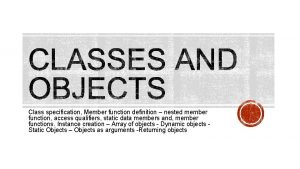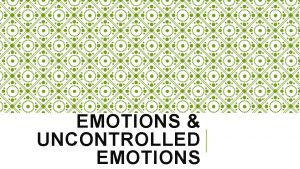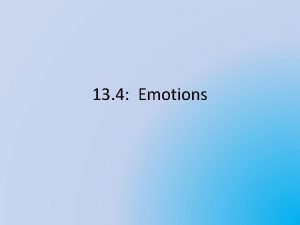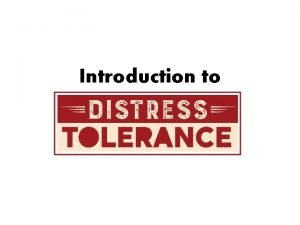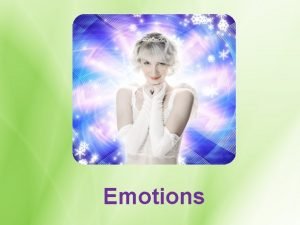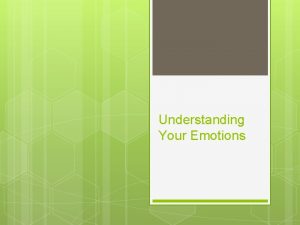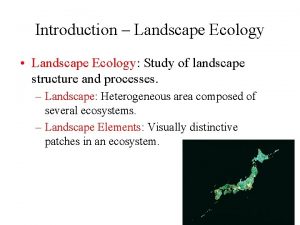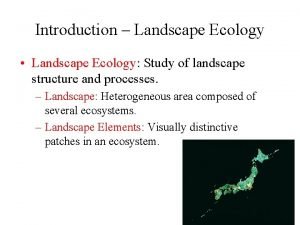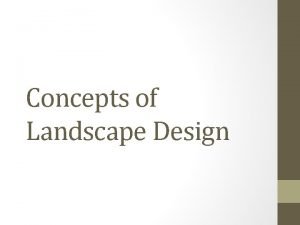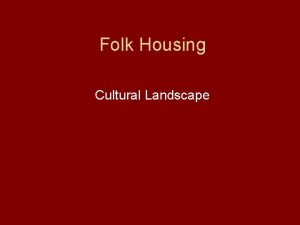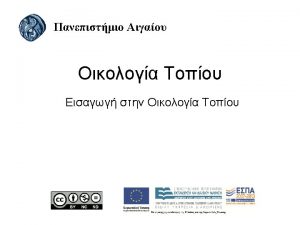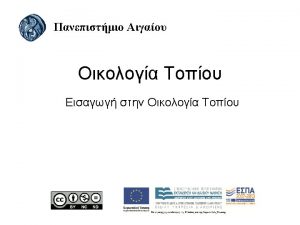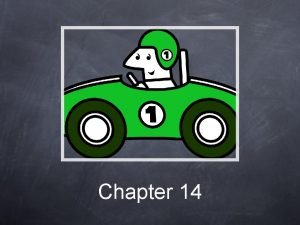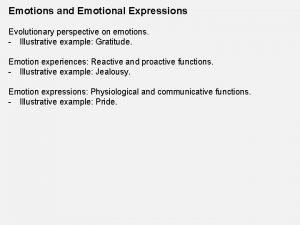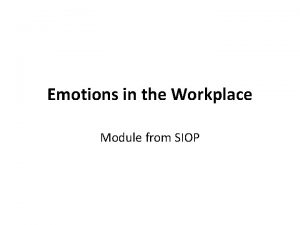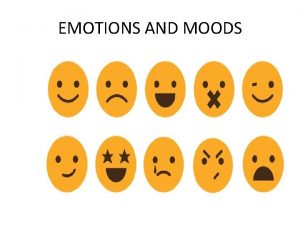Emotions Defined Class 4 THE LANDSCAPE OF EMOTIONS

























- Slides: 25

Emotions Defined Class 4

THE LANDSCAPE OF EMOTIONS What types? What features? What causes? What

Emotional Event You are talking with a friend as you walk. As you start to cross the street there is a screech of brakes. You stop your conversation, jump back onto the sidewalk. You find your heart pounding, thinking you could have been hurt, and you determine to be more careful, not to get so deeply involved in conversations. The event is evaluated as important, priorities are changed, interrupting your previous actions. You are shaken bodily, and you make plans about what to do. Let’s map the event / behavior / emotion / cognition

Ways of Defining Emotion Descriptive 1. What are the different types of emotions? 2. How do different emotions look, sound, feel? 3. How can emotions be measured/observed? Causal 1. What circumstances give rise to emotions? 2. How are emotions evoked? Functional 1. What do emotions do? What’s their purpose?

Emotion Terms Affect: Covers emotions, feelings, moods, and preferences. Preferences: Mild subjective reactions of positive/negative directed toward specific objects. ”Like / Don’t Like” Moods: General positive or negative states without a specific target. Emotions: Specific states directed toward specific targets. Feelings: Basically synonymous with emotions, but more direct reference to corresponding bodily sensation.

From Reflexes to Emotion a. Reflexes b. Patterns of action c. Innate releaser/sign stimulus/cue d. Emotions

Emotions and Action Patterns

Emotions Promote Action Readiness Action Ready to strike, hit, attack: Emotion Anger Wanting to flee, escape: Fear Wanting to join, touch, be with: Love, Affection

Emotional Cues and Action Patterns, Per Gary Larson It’s still hungry, and I’ve been stuffing worms into it all day.

Emotions and Problem Solving Emotions draw attention to problems Emotions keep attention on problems, until problems are solved. Different emotions are keyed to different kinds of problems EMOTION PROBLEM SOLUTION Betrayal of . Make another amends Guilt Restore Threat to self Self Fear bonds Protection

Non Verbal Signals of Emotion: Emotions Cause Us to Sing and Dance! Non Verbal Signal Emblems Enactment Thrust fist, extended middle finger, thumbs up Illustrators hand Accent/emphasis in voice, waving, clenched fist Affect Displays Smiling, frowning Regulators Nods, eyebrow movement Adaptors Self-touching, self grooming

“Pregnant” example of vocal expression of emotion. Twee maander zwanger “Three months pregnant”

Music of Emotional Expression https: //www. youtube. com/watch? v=Sn. Kulfk. NG 1 Q https: //www. youtube. com/watch? v=Ckxz 2 ipm. NAE

Map of 24 Emotional Signals Cowen, Elfenbein, Laukka, & Keltner, 2019 https: //s 3 -us-west-1. amazonaws. com/vocs/map. html# Created 2080 voice bursts (2032 in lab + 48 real world) by 1105 people. Emotional samples reduce to 24 distinct kinds of emotion. Supports distinct emotions (Ekman) more than Circumplex model (Russell) However, emotions seem to follow continuum versus discrete categories

How Keltner, Oatley, and Jenkins define emotion a. Emotion is caused by a person evaluating an event as relevant to an important goal; emotion is positive if event advances goal, negative if event impedes goal. b. Core of emotion is readiness to act. Emotions give priority to action. c. Emotions are experienced as distinctive mental states, sometimes accompanied by bodily changes, expressions, actions. Note: This is an appraisal approach to emotions Event Evaluation of Event Emotion

Goals, and Appraisal Theory of Emotion You are alone at party. Nice looking person looks in your direction, and smiles. But is smiling at person sitting next to you. YES Appraisal: Recognition of an event as significant. YES Significant events: Goal Relevance: Does event relate to goals? YES Goal Congruence/Incongruence: Does event ADVANC IMPED E E advance or impede goals? DIS Ego Involvement: How does event affect one’s AFFIRM sense of self (e. g. , affirm, dis-affirm)? EMOTION HAPPY UNHAP PY

Emotions Per Keltner, Oatley & Jenkins Goal Relevance: I’m looking for parking space and: Space suddenly opens, I feel: Euphorically, insanely Someone steals space, I happy Bloodthirsty rage feel: Readiness to act: I’m from the South, and space stealer sneers and says “Sorry, Slick”. My body reacts by: Fight mode, testosterone, cortisol, HR, etc. Distinct mental states: Not only is my body aroused, I am aware of my emotions and can label my emotions.

Appraisal Chain Goal Relevant? Yes Emotion Goal Congruent? Yes Positive Emotion Ego Not Involvemen Relevant t? Happiness Boosts selfesteem Pride Mutual Affection Love EVENT No No Emotion No Negative Emotion Damages self esteem Anger, Shame Threat to self Fear/Anxiet y Loss to self Sadnes

Appraisal Habits and Emotion: Cognitive/Behavioral Therapy (CBT) Event: Saw someone from school at market, but she didn’t acknowledge me. Emotion: Hurt, sadness Thought: Probably doesn’t like me. Depression Alternative appraisal: The person might not have even seen me. Or maybe she is shy, or maybe she is a stuck-up jerk. New emotion: Relief, Compassion, Distain

Changing Emotions By Changing Cognitions in The Dain Curse Dashiel Hammet, 1929 “I—” She sat down on the side of the bed close to me, elbows on knees, tortured white face between hands. “I’ve not ever been able to think clearly, as other people do, even the simplest thoughts. Everything is always so confused in my mind. No matter what I try to think about, there’s a fog that gets between me and it, and other thoughts get between us, so I can barely catch a glimpse of the thought I want before I lose it again, and have to hunt through the fog, and at last find it, only to have the same thing happen again and again. Can you understand how horrible that can become: going through life like that—year after year—knowing you’ll always be

Changing Emotions By Changing Cognitions in The Dain Curse “It sounds normal as hell to me. Nobody thinks clearly, no matter what they pretend. Thinking is a dizzy business, a matter of catching as many of those foggy glimpses as you can and fitting them together as best you can. That’s why people hang on so tight to their beliefs and opinions; because compared to the haphazard way they’re arrived at, even the goofiest opinion seems wonderfully clear, sane, and self-evident. …” She took her face out of her hands and smiled shyly at me saying: “it’s funny, I didn’t like you before. ”

Thinking and Emotions shift direction of thought: Mental radar Emotions focus attention to emotion-relevant things Emotions focus attention on to un-solved problems What was I supposed to discuss before class ends? Emotions can be changed by changes in

Do Emotions Shape Thought? From Bang the Drum Slowly Mark Harris, 1956 …We filled up with antifreeze, the kid in the station saying, “this will last you a lifetime”. You would be surprised if you listen to the number of times a day people will tell you something will last a lifetime or tell you something killed them, or tell you they are dead. “I was simply dead” they say, “He killed me, “ I am dying, ” which I never noticed before but now begun to notice more and more. For narrator, mortality is: hypercognized or hypocognized

Appraisal vs. Separate Systems Theories of Emotion Controversy: Do emotions always follow thought, or can emotion precede thinking? What comes first, thinking or feeling? Appraisal Theory: Thinking comes first. Richard Lazarus, George Mandler. Separate Systems: Emotions can come first. Robert Zajonc, Joseph Le. Doux

Examples of Appraisal vs. Separate Systems Appraisal: Cognition Emotion I find lottery ticket, scratch it, win $10. 00, feel ? ? ? South Fore finds lottery ticket, scratches if, finds $10, 000, feels ? ? ? Sep. Systems: Emotion Cognition You leave school, have jittery, disturbed “something’s wrong” feeling, can’t find reason, get home, realize you missed important meeting. Emotion is like radar—signaling something important
 Set is a collection of well defined objects
Set is a collection of well defined objects Member variable and member function
Member variable and member function Hình ảnh bộ gõ cơ thể búng tay
Hình ảnh bộ gõ cơ thể búng tay Lp html
Lp html Bổ thể
Bổ thể Tỉ lệ cơ thể trẻ em
Tỉ lệ cơ thể trẻ em Voi kéo gỗ như thế nào
Voi kéo gỗ như thế nào Chụp phim tư thế worms-breton
Chụp phim tư thế worms-breton Alleluia hat len nguoi oi
Alleluia hat len nguoi oi Các môn thể thao bắt đầu bằng tiếng chạy
Các môn thể thao bắt đầu bằng tiếng chạy Thế nào là hệ số cao nhất
Thế nào là hệ số cao nhất Các châu lục và đại dương trên thế giới
Các châu lục và đại dương trên thế giới Cong thức tính động năng
Cong thức tính động năng Trời xanh đây là của chúng ta thể thơ
Trời xanh đây là của chúng ta thể thơ Mật thư tọa độ 5x5
Mật thư tọa độ 5x5 101012 bằng
101012 bằng Phản ứng thế ankan
Phản ứng thế ankan Các châu lục và đại dương trên thế giới
Các châu lục và đại dương trên thế giới Thể thơ truyền thống
Thể thơ truyền thống Quá trình desamine hóa có thể tạo ra
Quá trình desamine hóa có thể tạo ra Một số thể thơ truyền thống
Một số thể thơ truyền thống Cái miệng xinh xinh thế chỉ nói điều hay thôi
Cái miệng xinh xinh thế chỉ nói điều hay thôi Vẽ hình chiếu vuông góc của vật thể sau
Vẽ hình chiếu vuông góc của vật thể sau Nguyên nhân của sự mỏi cơ sinh 8
Nguyên nhân của sự mỏi cơ sinh 8 đặc điểm cơ thể của người tối cổ
đặc điểm cơ thể của người tối cổ V cc
V cc

